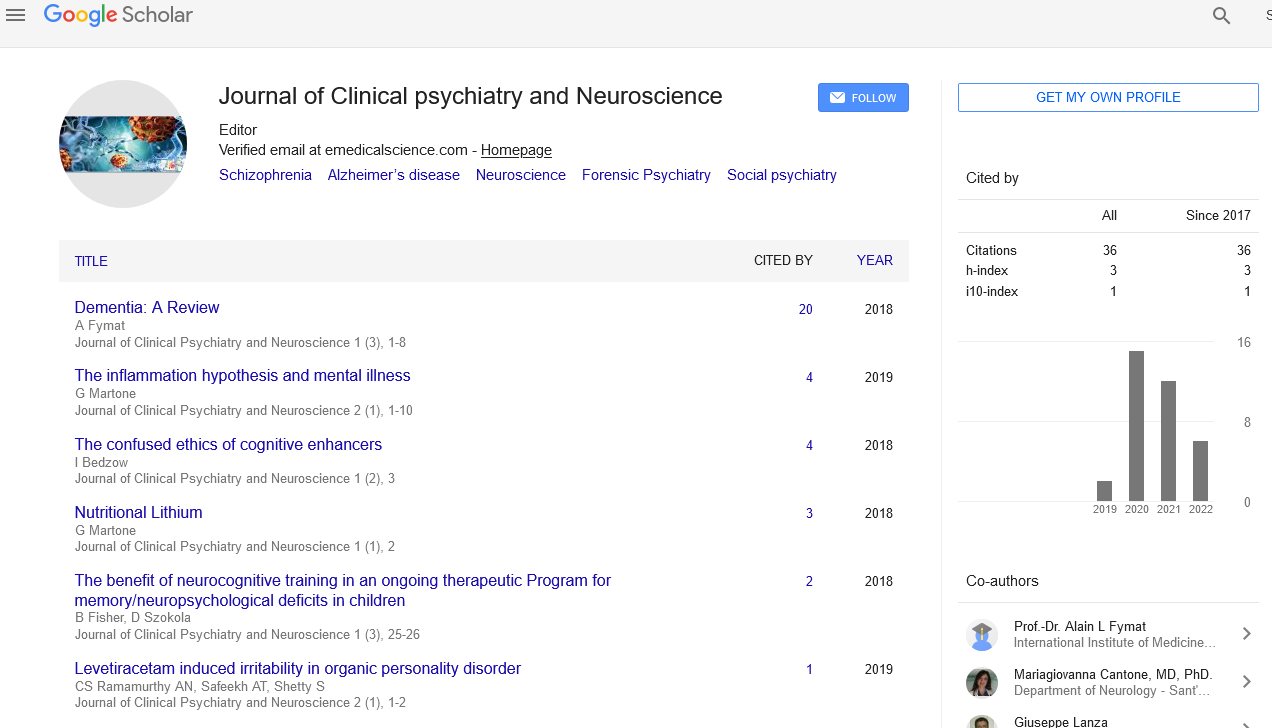Assessment of a multi-modular certifiable intercession for dementia
Received: 08-Sep-2021 Accepted Date: Sep 22, 2021; Published: 29-Sep-2021
Citation: Qin Z. Assessment of a multi-modular certifiable intercession for dementia. J Clin Psychiatry Neurosci 2021;4(5):2.
This open-access article is distributed under the terms of the Creative Commons Attribution Non-Commercial License (CC BY-NC) (http://creativecommons.org/licenses/by-nc/4.0/), which permits reuse, distribution and reproduction of the article, provided that the original work is properly cited and the reuse is restricted to noncommercial purposes. For commercial reuse, contact reprints@pulsus.com
About the Study
This implementation study assessed an original local area based Memory Wellness Program focusing on dementia risk decrease through expanding wellbeing data and wellbeing advancing practices in older adults. The nurse-lead eight-week program included the accompanying behavior change methodologies: Objective setting, education, group activity, and prologue to the utilization of iPads and Misfit action trackers. The multi-model program was conveyed in a real-world setting utilizing pop-up clinic run by a Registered Nurse, across 18 distinct sites. Utilizing a semi test mixed techniques plan, and a REAIM structure, the study assessed the scope, viability, reception, implementation and support of the MWP. A total of 179 older adults aged 65 years and over took an interest in the assessment across eighteen areas in three states and a domain of Australia. Paired t-tests were completed on all pretestpost test clinical data. In-depth interviews were led with seventeen members and staff.
Engagement in the program was related with further developed perception, brought down BP and stress and increased commitment with technology. There was a trend towards reduced feelings of loneliness. Members' primary motivations for undertaking the program were to further develop memory, meet new individuals and further develop technology use and Computer literacy, with most members detailing that these objectives had been met through the program. The program was viable across numerous sites exhibiting it can effectively be carried out in various context and that the scope of behavior change techniques suit a useful multi-modular program. This assessment of a community-based Memory Wellness Program showed increased intellectual capacity in older adults giving worries about their discernment and memory. The statistically critical outcomes and medium to large impact sizes recommend that further examination is justified to evaluate the viability of multi-modular community-based projects for further developing memory and psychological well-being with an emphasis on dementia risk reduction on older adults.
There is a need to foster more sensitive examination apparatuses to study technology use in the older population. The majority of our members previously used technology, which means the TIU instrument lacked sensitivity to identify any adjustment of utilization whether that is recurrence or application. Subjective data recommends that the iPad and Misfit activity tracker parts of the program did support and increases most members' commitment through learning new technology and additionally new online based exercises. Too, expansions in level of physical activity were reported for by a couple of interviewees however no shifting in the phases of changes utilizing the PA-SoC device. It is conceivable that any increase in activity happened for those all around in the activity or upkeep phases of progress, and we propose further work to quantify and consolidate this hypothetical methodology into real-world assessments. Strength of this study is that it assessed a real-world dependent on making an interpretation of proof into training. While the assessment has limits brought about by the real-world problems of gaps in program conveyance and data assortment, staff changes, and client drop-out, it additionally selected 'real population' with members in older age goes infrequently contemplated and surveyed implementation across 18 sites. The improvements in diastolic blood pressure, alongside the non-factual improvement in depression, close by the subjective reports of program satisfaction show that the MWP gave advantages to members.





